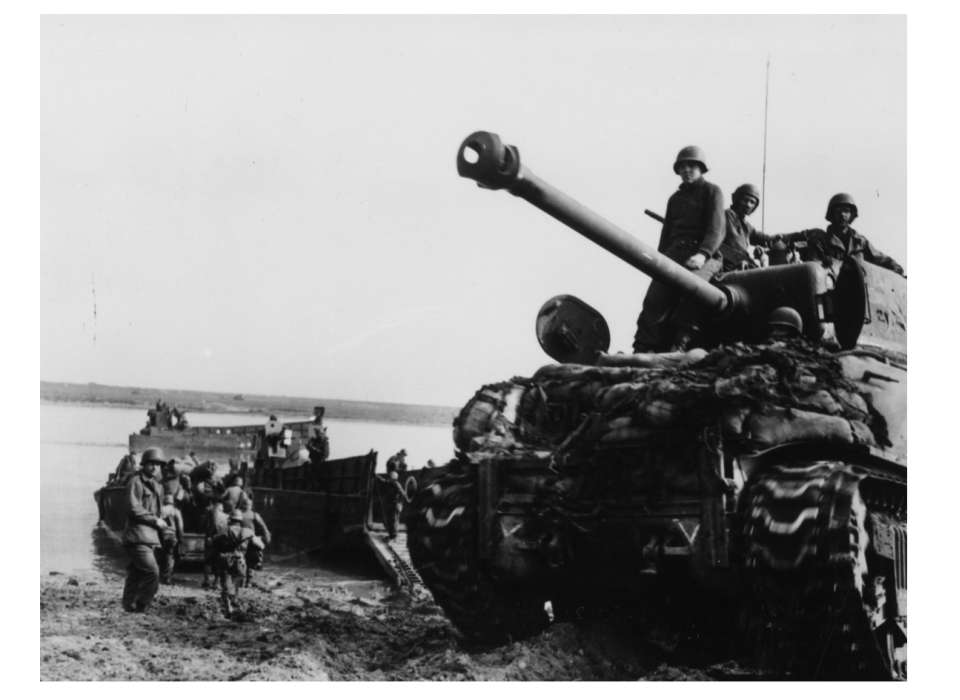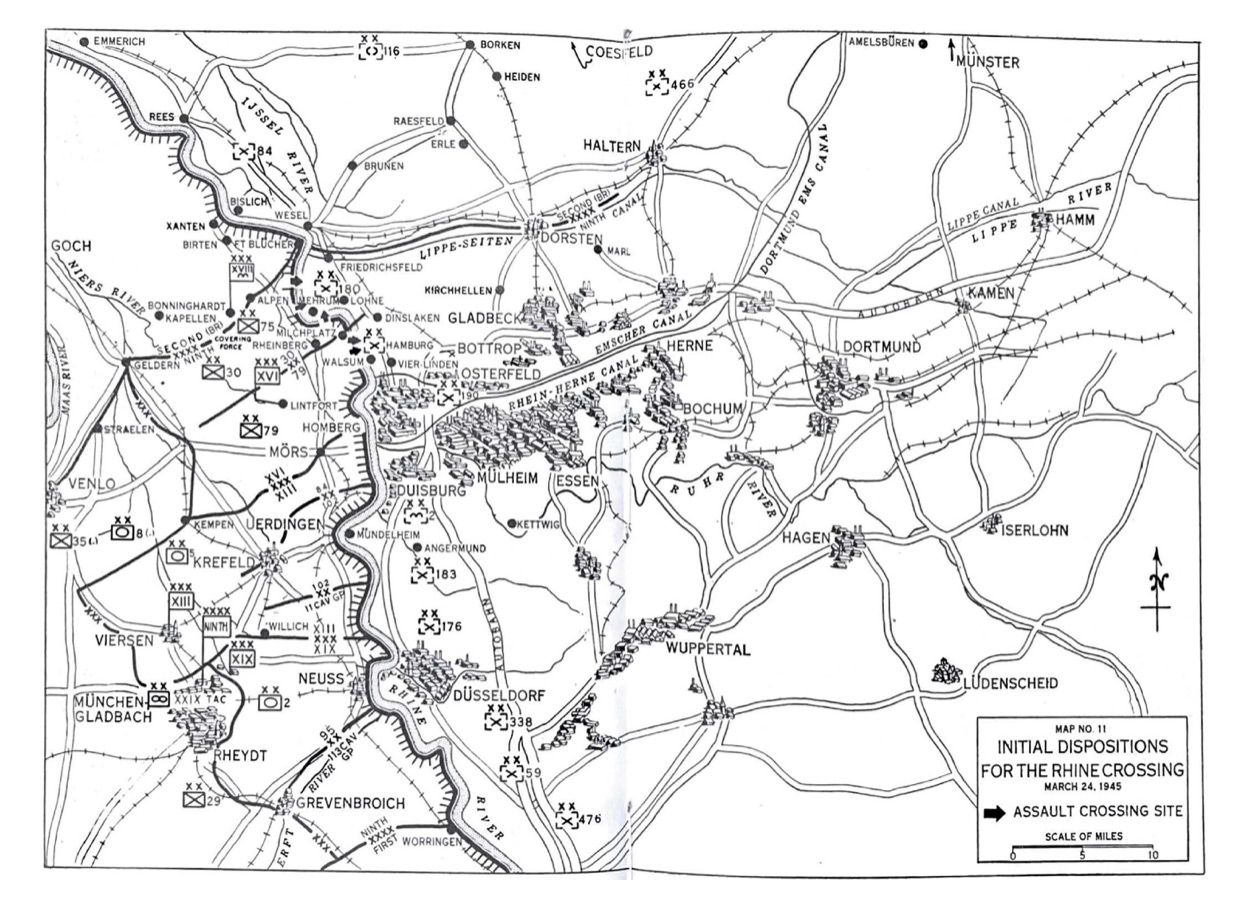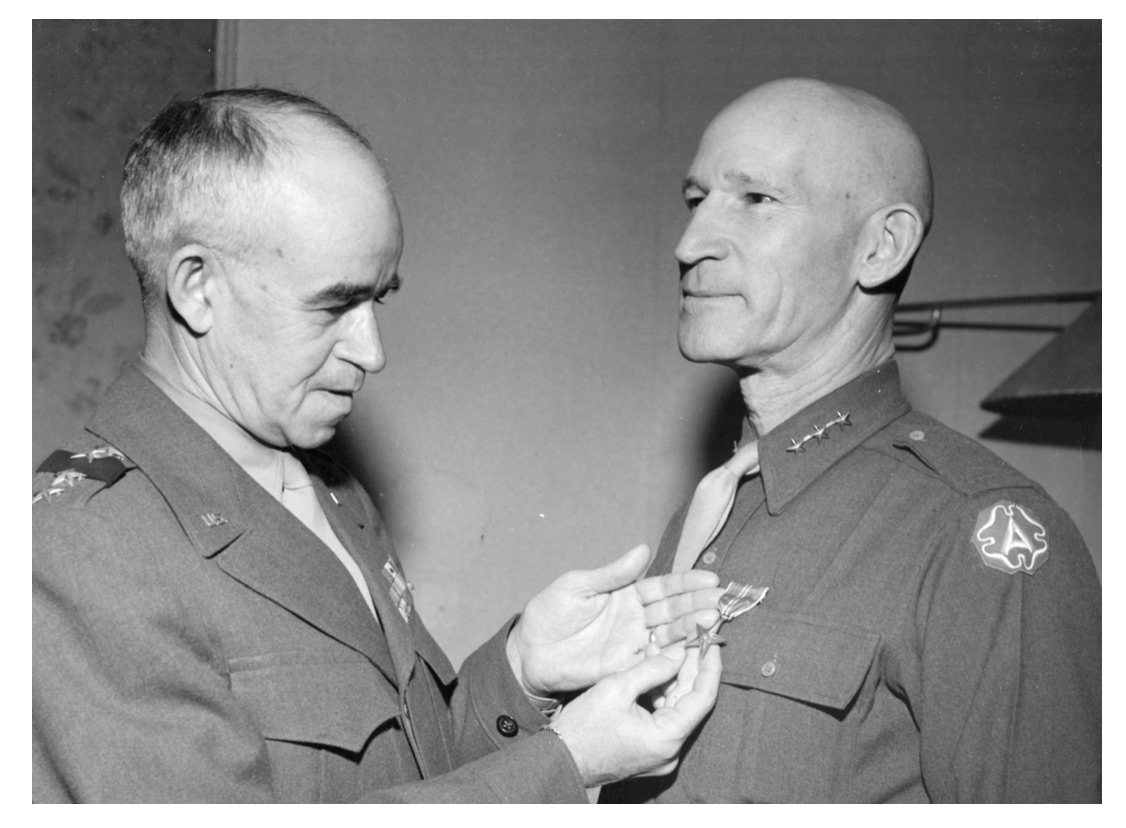Top image: 9th Army troops and weapons crossing the Rhine River, Germany, March 1945. National WWII Museum, https://www.ww2online.org/image/9th-army-tank-debarking-lcvp-rhine-riverbank-germany-1945
Much has been made in the historical record of the capture of the Ludendorff Bridge over the Rhine River at Remagen, Germany, in early March 1945. However, fewer accounts exist of Operation Flashpoint, the Ninth US Army’s assault crossing of the Rhine, which began on March 24. General William H. Simpson, commander of the Ninth Army, has received little attention in the historiography of World War II. He has no biography, and no scholarly operational history yet exists of the Ninth Army’s operations in northwest Europe in 1944-45. This is surprising given its combat record.
Simpson commanded the Ninth Army throughout its campaign in northwest Europe. His tour began in September 1944, when his headquarters disembarked in France over Utah Beach, and ended in May 1945. While under Simpson’s leadership, the Ninth Army captured more than 750,000 German prisoners of war, while liberating nearly 600,000 Allied POWs and 1,250,000 displaced persons.¹ Of Simpson, General Dwight D. Eisenhower wrote after the war: “If Simpson ever made a mistake as an Army Commander, it never came to my attention.”²
Simpson’s relative obscurity resulted in part from his service for most of the campaign under British Field Marshal Bernard L. Montgomery’s 21st Army Group. Eisenhower placed the Ninth Army under Montgomery’s command during the German Ardennes counteroffensive. The German penetration of Allied lines separated Lieutenant General Omar Bradley’s 12th Army Group headquarters in Luxembourg from his First and Ninth Armies to the north. This forced Eisenhower to transfer both armies to Montgomery’s 21st Army Group to reinstate effective command and control. When the Allies finally reversed the German gains in January 1945, Eisenhower returned the First Army to Bradley’s 12th Army Group, but left the Ninth Army under Montgomery’s command.
Eisenhower’s decision stemmed from a long-standing debate over Allied strategy in northwest Europe. A study completed in May 1944 by the Supreme Headquarters Allied Expeditionary Force (SHAEF) staff analyzed potential routes for the final offensive into Germany. Of the four routes considered, the planners believed two had strategic value: a southern route through Frankfurt and the Saar, and a northern route to the Ruhr Valley. The staff considered this latter, northern route more strategically advantageous, largely because it led directly to the Ruhr industrial valley, which was the heart of Germany’s war industry. Liberating the Ruhr Valley would cripple Germany’s ability to continue the war. Therefore, SHAEF designated this route the Allied main effort.
This created a challenge when the Allies considered future strategy in September 1944. Montgomery’s 21st Army Group occupied the northern part of the Allied line, but it lacked adequate combat power to execute main effort operations on its own. This required Eisenhower to either assign a US field army to the 21st Army Group, or split command of the main effort between Montgomery and Bradley. Neither choice was attractive to the Supreme Commander, but the first option won out on the basis of sound military principles. Thus, when Eisenhower returned the First Army to Bradley’s command in January 1945, he left Simpson under Montgomery to weight the main effort appropriately.
In February and early March 1945, the 21st Army Group crossed the Roer River and advanced to the western bank of the Rhine. Here preparations began for a river crossing operation that rivaled the Normandy invasion in scale. Code named Operation Plunder, Montgomery’s plan was massive, detailed, and deliberate. Two field armies—the British Second Army in the north and the Ninth US Army in the south—would cross the Rhine abreast at four crossing sites. A massive artillery barrage would precede the crossing, after which the war’s largest deployment of paratroopers in a single-lift, Operation Varsity, would take place across the Rhine, just north of Wesel.
The city of Wesel, situated near the center of the Allied bridgehead line, was the most important objective on the Rhine’s eastern bank, given its excellent roads and plentiful potential bridging sites. To speed its capture, British commandos would be among the first troops to cross the Rhine, outflanking Wesel’s defenders by landing north of the city and then attacking to clear it in support of follow-on troops arriving from the far side of the river. Meanwhile, the paratroopers landing northeast of the city would interdict German attempts to reinforce the landing sites and prevent artillery fire from ranging the bridgehead.
While planning for Operation Plunder began months earlier, final preparations in March involved a staggering amount of equipment and resources. The only Class 70 route (70-ton load capacity) for dozens of miles north or south ran through Wesel, highlighting its strategic importance. Just managing the traffic along this route was a major operation. In the lead-up to Operation Plunder, more than 600 tanks, 4,000 tank transporters, and 32,000 vehicles used this route to approach Wesel, while the same route supported the movement of a quarter-million tons of supplies and ammunition. Road and bridge maintenance alone tied up seven battalions of combat engineers.³ On March 23, the juggernaut that was the 21st Army Group stood ready to begin the assault into Germany.
Before dawn on March 24, after a one-hour bombardment of the 25-mile front by 3,500 Allied guns, Operation Plunder began. Three British corps crossed at Wesel, Xanten, and Rees, while two divisions of the Ninth Army’s XVI Corps, the 30th and 79th Infantry Divisions, crossed in assault boats near Rheinberg. At 10:00 a.m., the 3,500 airplanes and gliders of Operation Varsity dropped more than 20,000 paratroopers from the American 17th and British 6th Airborne Divisions. The paratroopers, under the command of Major General Matthew Ridgway’s XVIII Airborne Corps, quickly reached their primary objectives as the assault forces secured their bridgeheads on the Rhine’s eastern bank.⁴
By the afternoon of March 25, the Allies had made sufficient progress securing Wesel to allow bridging operations to begin. Stronger German resistance and tougher terrain at the northern crossing sites impeded progress there, as did the muddy, complex terrain and lack of roads around the Ninth Army’s bridgeheads south of the city. Simpson knew he would not be able to get his forces moving until he had access to both the crossing sites at Wesel and the highway heading east from there, running parallel to the Lippe River. Until then, they would remain bogged down just west of the Ruhr Valley, but British forces would have exclusive access to the Wesel crossing sites until March 31.
Growing impatient, Simpson met with Montgomery on the afternoon of March 26 to request early access to the crossing sites and highway. The Field Marshal was sympathetic to Simpson’s request but refused to give him control of the Wesel crossing sites until the British Second Army’s combat units completed their crossing. However, Montgomery did give Simpson control of the highway north of the Lippe River beginning March 30. Simpson saw this as an opportunity. Risking overcrowding of the already cramped bridgehead, he ordered several units originally slated to cross the river at Wesel to cross at the existing sites south of the city instead. Simultaneously, he coordinated with the 17th Airborne Division to seize crossing sites and build bridges over the Lippe River and Lippe Canal near Dorsten. This would allow elements of the 2nd and 8th Armored Divisions to cross to the north of these water obstacles on the March 30, rather than waiting another day or more to cross at Wesel. Once north of the Lippe, Simpson’s armored columns could turn east and press the attack without delay on good terrain.
Events on March 28 benefited Simpson’s plan, as British forces finally broke through enemy lines and began to drive east in earnest. Leading the charge was the British Guards Armored Division, which penetrated 17 miles into enemy territory with paratroopers of the 17th Airborne Division riding on their tanks, opening the way for the Ninth Army. On March 30, Simpson’s gamble paid off. XVI Corps armor supported by motorized infantry crossed the Lippe and headed east, advancing 80 miles in just 36 hours. On the 31st, with the Wesel crossing sites finally under Simpson’s control, the XIII Corps crossed the Rhine and advanced 60 miles in less than two days, liberating the city of Munster. As the German withdrawal turned to a rout, Allied forces of the Ninth and First Armies encircled the Ruhr Valley from the north and south, respectively, meeting near Paderborn. In the ensuing battle, Ninth Army forces captured more than 36,000 German troops caught in the encirclement for a loss of 2,400 casualties.⁵
Just as the Allied advance hit full steam, Eisenhower decided on April 2 to abandon Berlin as an operational objective. He would leave that prize to Stalin, halting the Anglo-American advance at the Elbe River. On April 4, Simpson’s Ninth Army returned to the 12th Army Group. While Simpson was pleased to be back under Bradley’s command, he was sorely disappointed that his field army would not participate in the liberation of Berlin. The fact that he was passed over for promotion to 4-star general on March 28, when Generals Bradley, Devers, Patton, and Hodges all received that honor, only made matters worse. Unlike his peers, Simpson had to wait until 1954 for congress to promote him and several other officers who served in the war to 4-star general.
Simpson was passed over for promotion in March 1945 for the same reasons that the Ninth Army’s exploits have garnered relatively little attention in the historiographical record. His association with 21st Army Group at a time of great stress for the Allied coalition marked him as a friend of the British—something few of his peers would have considered themselves. He did exactly what Eisenhower asked of him, and it is doubtful that any other American field army commander could have served under Montgomery with so little friction. Still, as postwar historians focused on American operations in the European theater of operations, they paid relatively little attention to the operations of the 21st Army Group, including those of Simpson’s Ninth Army.
Montgomery endured criticism both during and after the war for the scale of Operation Plunder, with some historians arguing that it was unnecessary and slowed the overall Allied advance into Germany. The relatively light resistance that the Allies faced after the crossing fueled this controversy. Still, at the time, Allied intelligence forecasted strong German resistance, and none wanted another setback like the failure to anticipate the powerful German counteroffensive in the Ardennes just three months earlier. Montgomery designed the set-piece Operation Plunder with an eye towards his legacy, and he left behind a classic example of a major river-crossing operation. Given that its overwhelming success came at a low cost in Allied casualties compared to other major operations in northwest Europe, a bit of overkill should be forgiven. After all, as General Simpson often said, “Never send an infantryman in to do a job that an artillery shell can do for him.”⁶
Additional Reading:
Ellis, L. F. Victory in the West, Volume II: The Defeat of Germany. History of the Second World War, edited by Sir James Butler. Nashville: Battery Press, 1968.
MacDonald, Charles B. The Last Offensive. United States Army in World War II: European Theater of Operations, edited by Maurice Matloff. 1973. Reprint, Washington, DC: United States Army Center of Military History, 2000
Parker Jr., T. W., and William J. Thompson, eds. Conquer: The Story of the Ninth Army. Washington, DC: Infantry Journal Press, 1947.
¹ T. W. Parker Jr., and William J. Thompson, eds., Conquer: The Story of the Ninth Army (Washington, DC: Infantry Journal Press, 1947), 364-67, https://archive.org/details/ConquerTheStoryofNinthArmy.
² Dwight D. Eisenhower, Crusade in Europe (New York: Da Capo Press, 1948), 605, Kindle.
³ L. F. Ellis, Victory in the West, Volume II: The Defeat of Germany, History of the Second World War, ed. Sir James Butler (Nashville: Battery Press, 1968), 286-87.
⁴ Charles B. MacDonald, The Last Offensive (Washington, DC: United States Army Center of Military History, 1973; repr., 2000), 294-320.
⁵ T. W. Parker Jr., and William J. Thompson, eds., Conquer: The Story of the Ninth Army (Washington, DC: Infantry Journal Press, 1947), 283, https://archive.org/details/ConquerTheStoryofNinthArmy.
⁶ Leonard Mosley, Marshall, Organizer of Victory (London: Methuen, 1982), 326.
Mark T. Calhoun, PhD
Mark T. Calhoun, PhD, is a former Senior Historian at the Jenny Craig Institute for the Study of War and Democracy.
Cite this article:
MLA Citation:
APA Citation:
Chicago Style Citation:










![Max Fuchs, New York City cantor, sings as Rabbi Sydney [sic] Lefkowitz, Richmond, VA, conducts the first Jewish services from Germany.](/sites/default/files/styles/max_650x650/public/2025-10/image1.jpg)



